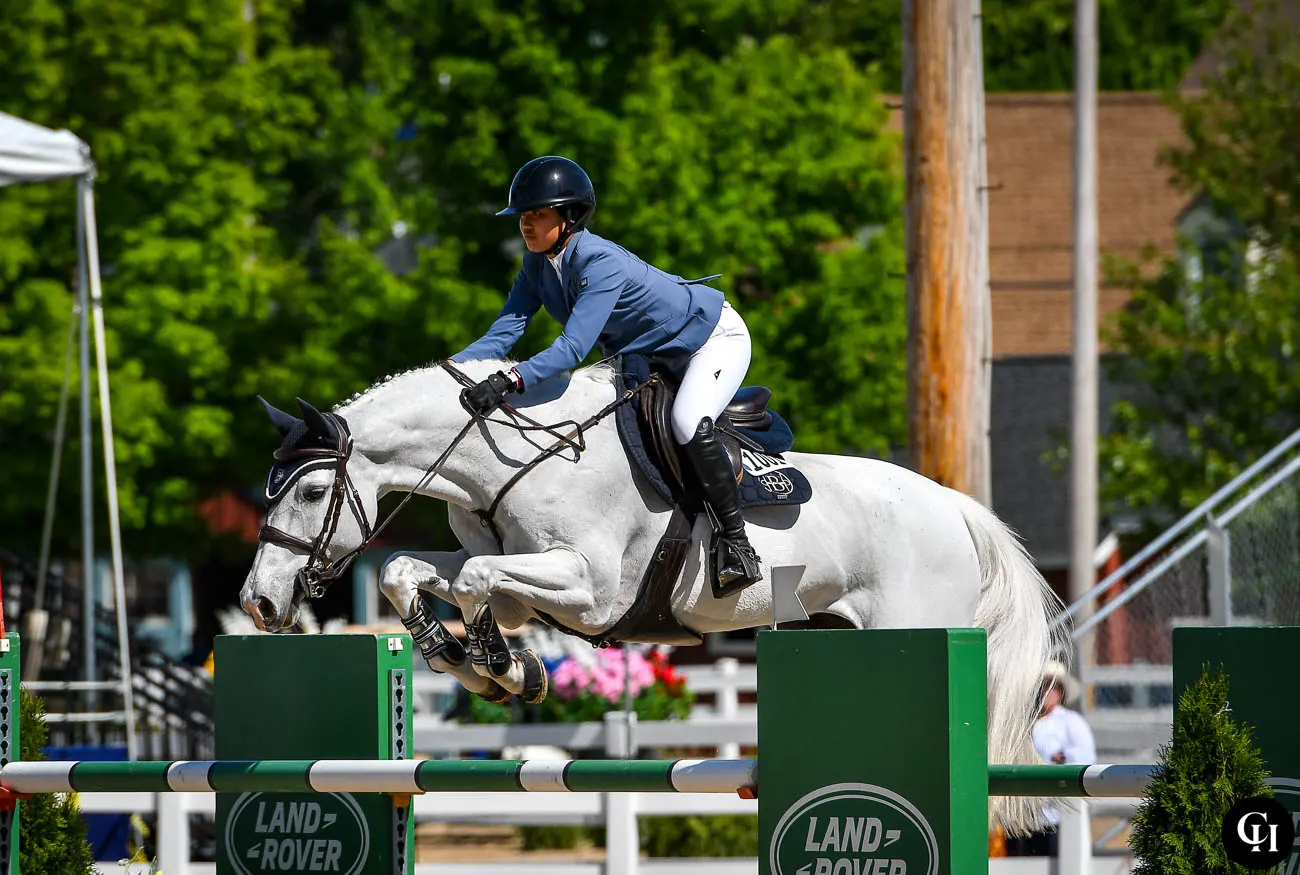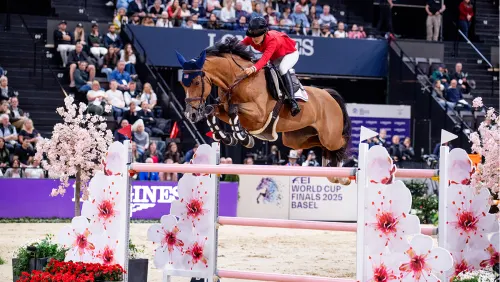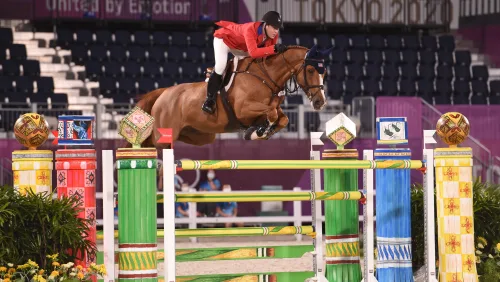Mimi Gochman is already an experienced and successful competitor at age 19, but the Brown University student is quick to say she’s not a veteran of the show jumping world she’s turned her attention to in the past few years.
Although she’s had some big successes, including most recently her win in the $226,000 CSI4* Upperville Jumper Classic (Virginia) aboard Gochman Sport Horse LLC’s Cosmos BH, Gochman is frank about the learning curve involved in moving from the equitation and hunter rings to the grand prix jumpers and, more specifically, the pressure of riding for a team.
“I consider myself a very calm rider, but the team atmosphere can bring out the nerves,” she said. “I never thought I would be nervous; I’ve always felt like I ride better under pressure, especially when I did equitation finals. I have to remember to have a solid plan but not be too rigid and perfect. My rounds are never going to go exactly as I want to, and I have to adapt when they don’t. My eventual goal is to be a very strong team member for a long time.”

Gochman grew up on the hunter/jumper circuit with her mom, top amateur hunter rider Becky Gochman, and her sister, Sophie Gochman, riding with hunter trainers Scott Stewart, Ken Berkley, and Grand Prix rider Amanda Derbyshire. As a junior rider, Mimi successfully competed in the hunter, jumper, and equitation ranks and amassed many accolades, including an individual gold medal at the 2021 North American Young Rider Championships, numerous championships in the junior hunter divisions, and she also competed in all the major 3’6” junior equitation finals.
She transitioned to the jumpers and contested her first grand prix in 2021.
“When I looked at the sport and where I want to be in the future, I really want to be representing the U.S. on a [show jumping] team and show at the biggest shows in the world,” Mimi said. “I really enjoyed hunters as a junior, but I was always more excited by the show jumping opportunities I received. It’s hard to mix the hunters and the jumpers together because of how different they are.”
Mimi has spent the past year training with Irish show jumper Darragh Kenny, who is based near the Gochmans’ northern farm in Armonk, New York, and also goes to Wellington, Florida, for the winter.
“I want to further my riding career and step into a higher level of show jumping, and I wanted someone who could teach me how to run a business successfully in the horse show world,” Mimi explained. “Darragh runs his own successful business, and he spends time in America too; he’s not just based out of Europe for the summer. That was important to me.”
Two of Mimi’s top mounts are Celina BH, a 14-year old Holsteiner mare (Canstakko—Carrera, Carthago Z) Mimi has competed with all over Europe, and Cosmos BH, an 11-year old Zangersheide stallion (Chellano Alpha Z—Aida Z, Artos Z).
Gochman has now represented her country on a handful of Nations Cup teams, and in November was named the winner of the FEI Rising Star Award in Mexico City. We caught up with her after her win at Upperville to discuss her thoughts on riding for the U.S. team, her horses, and the goals she’s working toward.
You’ve ridden on several U.S. Nations Cup teams since we caught up with you last in late 2022. How does it differ riding for the team versus riding/showing for yourself?
It’s more different than I originally thought. As a junior rider, when I did Young Riders or rode on the younger U.S. teams, I never really felt crazy amounts of pressure. I felt confident in my riding, and I felt like I would have good rounds.
But when I started to do the senior teams, it was way different. My first senior Nations Cup [in 2022 in Spain] didn’t go as well as I hoped. I’m hoping I can learn to be mentally stronger to do it better; right now I don’t trust my instincts as much as when I’m riding for myself. It’s not that I don’t have the training or skill to do it, but it’s about mentally staying calm. I’m working on that.
If I don’t do well on the team, then the whole teams suffers from my mistake. Last year, I had two Nations Cups where I gave a great performance and then two where I didn’t do as well as I wanted. I consider myself a very calm rider, but the team atmosphere can bring out the nerves.
I’m hoping I can learn to be mentally stronger to do it better; right now I don’t trust my instincts as much as when I’m riding for myself. It’s not that I don’t have the training or skill to do it, but it’s about mentally staying calm. I’m working on that.
Mimi Gochman, on riding for a team
I never thought I would be nervous. I’ve always felt like I ride better under pressure, especially when I did equitation finals. I have to remember to have a solid plan but not be too rigid and perfect. My rounds are never going to go exactly as I want, and I have to adapt when they don’t. My eventual goal is to be a very strong team member for a long time.
ADVERTISEMENT
In your experience, how do European shows and U.S. shows differ from one another? Are there any notable differences?
On a personal level, the competitiveness is different. I’m very used to the competition in America. I’m comfortable with all of my fellow competitors, I know them, and I’ve grown up competing with them. It’s a totally new scene in Europe. I’ve never been in that environment with those riders. I know their names, but I don’t know all of them personally. I hope to get more experience in Europe.
Not that America doesn’t have prestigious shows, but it also feels more prestigious in Europe at their horse shows. The local people are very interested in horse shows because horses are an important part of their lives. Take Aachen (Germany) for example: Their showgrounds are steeped in history, which changes the outlook for locals. It’s a thing in Europe—you go to the horse shows and watch. Recently, I think the U.S. shows have started doing a better job of getting local crowds involved.

How has competing on teams changed your perspective on riding in general?
Honestly, competing at Spruce Meadows changed my perspective on everything. This past fall [September 2023], I competed on the [Nations Cup] team there, and it was the biggest team I had been on; I was excited but nervous. And then I fell off there, and that was the first fall that I was actually scared to show afterwards. I probably bruised a few ribs, and Celina had to get a few stitches. We got lucky.
But I think that experience will help me going forward. I think team riding teaches you a lot more about the mental game. It’s good for you, and I hope to make several more teams this summer. I’ve learned that even if you don’t win, if you put your best effort and round in, then you’ve achieved your goal. When I make mistakes, I’m ready to learn from them and get better. I’m still learning—it’s not just about producing the results but howto produce the result. I still have so much more to learn, I’m not a veteran of this sport.
When and where did your first meet Cosmos BH, and how did you know he was the horse for you?
I tried Cosmos spring of 2022; he was at Paul Schockemöhle’s stables in Germany. Our ultimate goal was to find a horse who could do five-star grand prix [classes] with me. At the time, I was jumping three- and four-star grand prix with Celina, and I needed another horse to do at that level. It’s too hard and demanding on one horse; you need a second one at that level.
Initially, I tried a different horse before Cosmos, but I loved both of them. I was having a hard time deciding between the two options. Out of the two options, Cosmos was a more inexperienced 9-year-old, which was why I was a little hesitant. Amanda [Derbyshire] and Ken [Berkley] really thought Cosmos was going to be a great horse. He didn’t have a huge record because of the COVID quarantine, but he had so much potential and had jumped the young horse classes in Aachen. So I went with Cosmos. He can jump big jumps.
When I first got Celina, Amanda rode her for several years and put experience on her in Europe before I took over showing her in 2020. But with Cosmos, he was the first younger horse that I sat on and figure out on my own. He keeps improving all the time. He’s a very good stallion; he’s not naughty or anything. I got very lucky with him, and he has an incredible personality.
Can you tell me a bit about what it’s like riding a horse like Cosmos BH? How has your relationship strengthened over the past year?
Riding Cosmos is easy. He’s got everything you could ever want: scope, careful, quick, a huge heart and good energy. When I go looking for horses now, I think about the qualities he has, and that’s what I look for. There’s not much you can fault him on.
We work a lot of fitness with him and try to keep him strong behind. Cosmos has a big stride, so we have to remind him to rock back on his haunches a lot. He’s also soft, which is uncommon in top show jumpers.
He’s pretty perfect, which I feel like people don’t say very often. He’s easy to work with, and he’s super smart. You do see that a lot in stallions, but he’s intuitive. Cosmos is always willing to try something; he’s not stubborn. He’s not easily offended either. When I make mistakes, he doesn’t get offended with me. He knows he’s the star in the barn too. He thinks he’s the best, and that helps him, I think.
What were some thoughts that went through your mind when you jumped clear in the first round of the $226,000 CSI4* Upperville Jumper Classic at Upperville?
Overall this year, I’ve been working on being more consistent in the jump-offs; I really wanted to jump double clear in this particular class. When I was a junior, I could jump the high junior classics so fast and so confidently. But then when I started to jump the grand prix and FEI classes, I would go fast in the jump-offs and tear down the course. I did the same at [this year’s Sapphire] Grand Prix [in Devon, Pennsylvania] with a different horse—I had the fastest time but had two down in the jump-off. So now, I’ve been practicing going fast in the right places for the jump-offs instead of running full speed the whole way.
ADVERTISEMENT
At Upperville this year, I did the national grand prix and the welcome stake, and I chipped in both trying to go fast in the jump-off. For the four-star class, I didn’t want to have a rail or chip, and I wanted to be smooth. I also got lucky enough that my round was fast enough to win.
Darragh jumped the four-star class too and he was able to watch a lot of it. Before I went in for the jump-off, he gave me some pointers through the turns and in places he thought others were struggling. It’s truly a team effort—if I hadn’t gotten those pointers from Darragh, then I may not have been as successful.
How many years have you been showing with your family at Upperville? What did that win mean to you?
We’ve been going to Upperville since I was 11 or 12 years old. I love Upperville. We always make it a point to go every year. It’s not a high-stress show, which is nice. My mom, my sister and I can go support each other at every ring in every class. It’s nice for the horses and the riders there; they do a good job. It’s also close enough to home that my whole family will come.
All of our retired horses live down the road from the show, so we go visit them too. It meant a lot to me to have that first big win there—for it to all come together like that, it was really special. My sister and my mom also had a great week, and I’m grateful for those moments and memories.
I know your sister took a brief hiatus from showing. Is it nice to have her showing at the same shows with you again?
I love showing with Sophie. We like riding together. Honestly it felt weird not having her at the shows for a little bit. I’m used to having her there. It’s nice to support her and vice versa. We’re old enough now where it’s fun to show together.
Is there anything specifically that you’ve been focusing on with your riding recently? How have you been doing this?
Getting better at the jump-offs has really been my main focus for competition riding. But one of my new goals is learning to develop younger horses with the goal of selling them, from 7 years old to when they’re ready to jump five-star grand prix or the U25 grand prix classes, or whatever they want to do. That comes with a lot of patience, which I’m working on!
Your base of riding has to be super strong—like your flatwork, your discipline, work with cavalettis and little jumps, teaching them correctly the first time and not teaching them bad habits, and learning to break down an exercise for a horse that’s confused so he understands. I also ask for help as much as possible because I can use those techniques in the future to better my horses.
Developing horses is a collaborative effort—no one ever does this sport alone. If you do it alone, kudos to you. But I have a very strong team behind me, and I’m grateful for that.
Aside from school, do you have any other goals that you’re working towards outside of riding right now?
No. Most of my goals are a combination of school and riding right now. I’m enrolled at Brown University. I want to run a business, and that’s what I’m trying to focus on in school. Riding is all about gaining experience, so that’s where I am right now.
What are your goals for the remainder of this year into next?
I applied for two Nations Cup teams, and I hope to make one of those teams. I will be in Europe this summer and compete in four- and five-star FEI grand prix. In the future, within the next two years, I’m looking toward qualifying for FEI World Cup Finals—those qualifiers are during the fall, which could make it hard with school. But I would like to qualify for that. Eventually I would love to jump on a U.S. championship team. I would like to also do more Major League [Show Jumping] tours.














